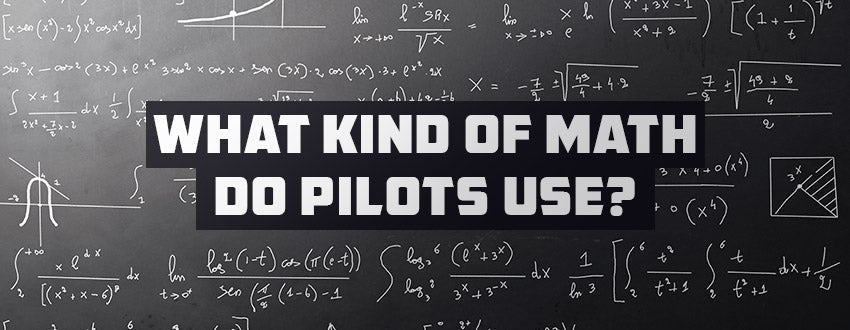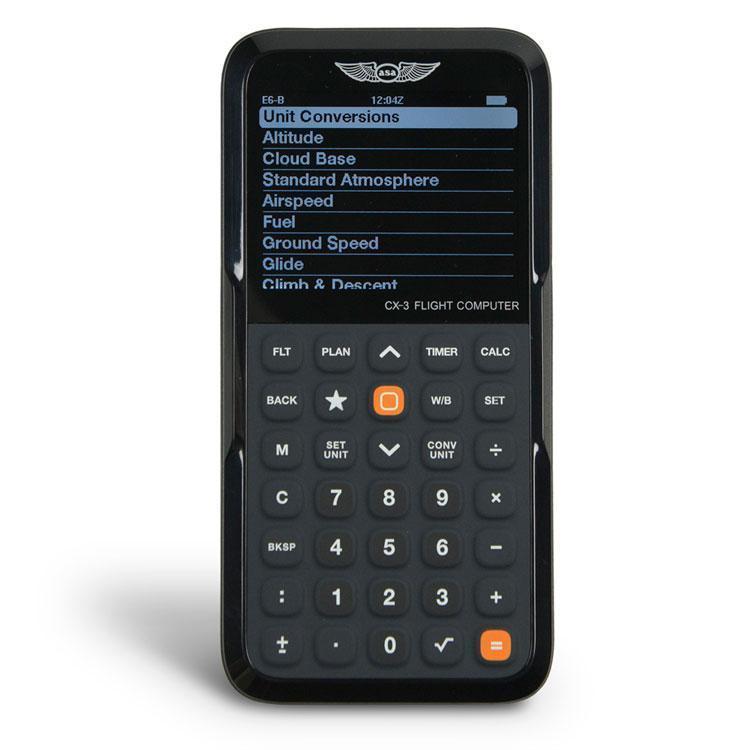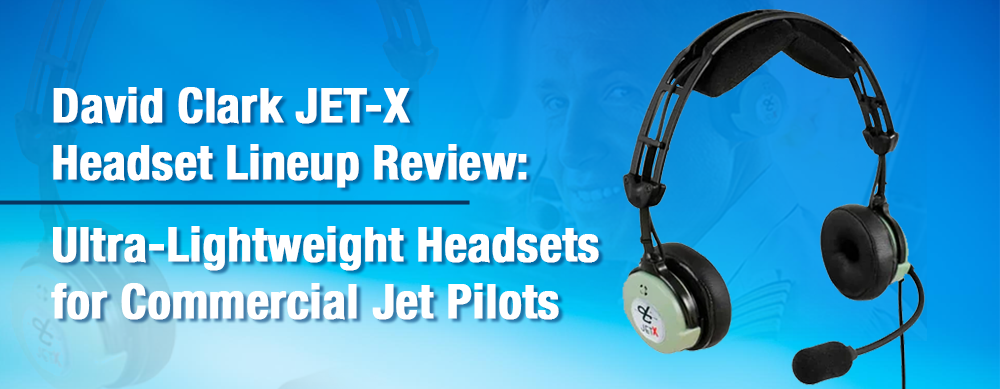Prospective pilots often wonder, "Do you need strong math skills to become a pilot?" Good news—the answer is no. Pilots mainly use basic math like arithmetic, geometry, and simple trigonometry, assisted by flight computers and aviation apps. This guide will clearly explain which math pilots actually use, demonstrate real-world examples with step-by-step calculations, and provide tips and tools to make mastering "pilot math" straightforward and stress-free.

Why Pilots Need Math (It’s Simpler Than You Think)
Every phase of flight—from pre-departure planning to landing—relies on numbers: fuel quantity, aircraft weight limits, crosswind corrections, and descent calculations. Fortunately, these calculations are straightforward once you understand the concepts behind them. Typically, you:
- Choose the correct formula or rule of thumb,
- Plug in your numbers (usually with a flight computer or app),
- Verify the result using quick mental math.
Types of Math Pilots Use in Aviation
| Math Concept | How Pilots Use It |
|---|---|
| Basic Arithmetic | Passenger and cargo weights, fuel calculations, flight times. |
| Algebra (Solving for x) & Interpolation | Performance-chart interpolation, solving for unknown variables based on surrounding data. |
| Geometry | Runway alignment, traffic patterns, holding patterns, glidepath angles. |
| Trigonometry | Wind corrections, crosswind components, navigation adjustments. |
| Mental Math | Quick estimates and cross-checks of time, fuel, and descent rates in-flight. |
Basic Arithmetic
Basic arithmetic (addition, subtraction, multiplication, and division) is fundamental. Pilots regularly use these skills for tasks like calculating total aircraft weight or the fuel needed for a flight. Since this is often done manually or mentally, accuracy is key.
Algebra & Interpolation
Interpolation is a technique using basic arithmetic and algebra to estimate values between known data points. Pilots use this, for instance, when reading performance charts where exact conditions might not be listed; they interpolate between the closest known values to estimate performance under their specific conditions.
Geometry
Geometry focuses on shapes, sizes, and spatial relationships. It's valuable for understanding runway alignment, visualizing traffic and holding patterns, and calculating glidepath angles for landing. Understanding basic geometric principles helps pilots visualize their position and required movements in 3D space.
Trigonometry
Trigonometry deals with the relationships between the sides and angles of triangles. Pilots apply this to calculate wind correction angles needed to maintain a desired course despite wind, and crucially, to determine crosswind components for safe takeoffs and landings. While the underlying math is trigonometric, tools like the E6B or calculator apps simplify the process.
Mental Math
Even with calculators and avionics, pilots must maintain strong mental math skills. This is essential for quick estimates, verifying electronic calculations, and making rapid decisions, especially during unexpected situations. Mental math is a learned skill that improves with practice.
How Pilots Apply Math During Flight (Overview)
Math is used throughout the flying process for critical calculations related to safety and performance. Here are some key areas where pilot math is applied:
- Weight & Balance: Ensuring the aircraft's weight is within limits and properly distributed.
- Fuel Calculation & Range: Determining the necessary fuel load for a flight, including reserves.
- Crosswind Component: Calculating the strength of wind perpendicular to the runway to assess safety limits and plan corrections.
- Descent Planning: Figuring out when to start descending and the required rate to reach the runway at the correct altitude and angle.
- Navigation: Calculating groundspeed, time en route, and required headings, especially when not solely relying on GPS.
- Performance: Determining takeoff and landing distances, climb rates, and cruise speeds based on atmospheric conditions and aircraft weight.
These calculations are vital for safe and efficient flight. Below, we'll walk through some detailed examples to show you exactly how this math is done.
Detailed Calculation Examples
Let's look at some specific examples, using formulas and step-by-step calculations similar to what a pilot would perform during pre-flight planning.
Weight & Balance Calculation Example
Aircraft cannot take off if they exceed their maximum takeoff weight. Pilots must calculate the total weight of the aircraft before every flight. This involves adding the weight of everything onboard to the aircraft's empty weight.
Let's use the example of a Cessna 180K from the old article:
- Empty Weight (the aircraft itself): 1,650 pounds
- Maximum Takeoff Weight (limit set by manufacturer): 2,810 pounds
First, calculate the **Useful Load**, which is the maximum weight of fuel, passengers, and cargo you can add:
Formula: Maximum takeoff weight – Empty weight = Useful Load
Calculation: 2,810 lbs – 1,650 lbs = 1,160 pounds Useful Load
This means you can add a maximum of 1,160 pounds of people, bags, and fuel to the aircraft. You would then weigh all passengers, baggage, and cargo, calculate the fuel weight (shown next), add them together, and ensure the total does not exceed the 1,160 lb useful load limit.

Learn more about weight distribution in our guide on Aircraft Weight and Balance Essentials.
Fuel Calculation Example
Calculating the required fuel ensures you have enough to reach your destination, plus necessary reserves according to regulations (like the FAA requirement for a 45-minute reserve for VFR flight during the day). Fuel calculations typically involve multiplication and addition.
Using the same Cessna 180K example:
- Average Fuel Burn: 13 gallons per hour (GPH)
- Destination Flight Time: 2 hours away
- Avgas Weight: 6 pounds per gallon
First, calculate the minimum fuel needed to reach the destination:
Formula: Per hour fuel burn × Number of hours = Gallons of fuel needed
Calculation: 13 GPH × 2 hours = 26 Gallons needed for trip

Next, convert gallons to pounds, as aircraft weight & balance is done in pounds:
Formula: Gallons of fuel needed × Weight per gallon = Fuel weight for trip
Calculation: 26 gallons × 6 lbs/gallon = 156 pounds fuel for trip

Now, add in the regulatory fuel reserves. Let's assume the most distant alternate adds an additional 15 minutes of flight time, and the required reserve is 45 minutes. Total additional time is 15 min + 45 min = 60 minutes (or 1 hour).
Calculate fuel needed for the additional time:
Formula: Per hour fuel burn × Additional hours = Additional Gallons needed
Calculation: 13 GPH × 1 hour = 13 Gallons additional fuel

Convert additional gallons to pounds:
Formula: Additional gallons of fuel × Weight per gallon = Additional Fuel weight
Calculation: 13 gallons × 6 lbs/gallon = 78 pounds additional fuel

Finally, calculate the total fuel weight required:
Formula: Minimum fuel weight + Additional fuel weight = Total fuel weight
Calculation: 156 pounds + 78 pounds = 234 total pounds of fuel needed

This 234 pounds is the amount you must add to the weight of passengers and cargo, ensuring the total is within the useful load calculated earlier (1,160 lbs in this example).
Crosswind Component Calculation Example
When wind is blowing across the runway, it creates a crosswind component that affects takeoff and landing. Pilots calculate this to determine if conditions are within the aircraft's and their own personal limits, and to plan control inputs.
Precise calculations use trigonometry. The angle (θ) is the angle between the wind direction and the runway direction.
Formula: Crosswind Component = Wind Speed × sin(Angle between wind and runway)
(*Note: The old article used cosine, which is for the headwind/tailwind component. Crosswind uses sine.*)
Let's say the wind is reported at 40 knots from 060°, and the runway is 090°. The angle between the wind and the runway is 090° - 060° = 30°.
Calculation: Crosswind Component = 40 knots × sin(30°)
Since sin(30°) = 0.5:
Crosswind Component = 40 knots × 0.5 = 20 knots
This 20-knot crosswind component must be compared to the aircraft's maximum demonstrated crosswind component (found in the POH) and the pilot's comfort level and experience.
Pilots also use a helpful rule of thumb for crosswind estimations, especially without a calculator handy:
- Angle is 15°: Crosswind is approximately 25% of wind speed. (40 kts * 0.25 = 10 kts)
- Angle is 30°: Crosswind is approximately 50% of wind speed. (40 kts * 0.50 = 20 kts - matches our calculation!)
- Angle is 45°: Crosswind is approximately 75% of wind speed. (40 kts * 0.75 = 30 kts)
- Angle is 60° or more: Crosswind is approximately 100% of wind speed. (40 kts * 1.00 = 40 kts)
If your precise calculation is far off from your rule-of-thumb estimate (e.g., calculating 40 knots crosswind with a 30° angle), it's a flag to double-check your work.
Descent Rate Calculation Example (3° Glidepath)
For a stable approach and landing, pilots need to descend at a rate that keeps them on the correct glidepath angle (often 3°). This requires calculating the descent rate based on their groundspeed.
Visualize a right triangle where the vertical side is the altitude loss, the horizontal side is the distance covered over the ground, and the hypotenuse is the flight path. The angle between the ground and the flight path is the glidepath angle (e.g., 3°).
Using trigonometry (specifically the tangent function), the relationship is: tan(glidepath angle) = (altitude loss per minute) / (groundspeed per minute).
We want to find the 'altitude loss per minute', which is the descent rate. So, the formula is:
Formula: Descent Rate (ft/min) = Groundspeed (ft/min) × tan(Glidepath Angle)
Let's use a groundspeed example of 100 knots and a standard 3° glidepath:
First, convert groundspeed from nautical miles per hour (knots) to feet per minute:
- There are 60 minutes in an hour.
- There are approximately 6,080 feet in one nautical mile.
Step 1: Convert Groundspeed to Nautical Miles per Minute
Formula: Groundspeed (kts) / 60 = Groundspeed (nm/min)
Calculation: 100 kts / 60 minutes = ≈ 1.667 nm/min
Step 2: Convert Groundspeed to Feet per Minute
Formula: Groundspeed (nm/min) × Feet per nautical mile = Groundspeed (ft/min)
Calculation: 1.667 nm/min × 6,080 ft/nm = ≈ 10,136 ft/min

Now, calculate the required descent rate using the main formula:
Formula: Descent Rate (ft/min) = Groundspeed (ft/min) × tan(Glidepath Angle)
Calculation: Descent Rate = 10,136 ft/min × tan(3°)
Since tan(3°) ≈ 0.0524:
Descent Rate = 10,136 ft/min × 0.0524 ≈ 531 ft/min

For quick mental estimation on a 3° glidepath, pilots use a simple rule of thumb:
Rule of Thumb: Descent Rate (ft/min) ≈ Groundspeed (kts) × 5
Calculation (Rule of Thumb): 100 kts × 5 = 500 ft/min
As you can see, the rule of thumb (500 ft/min) is very close to the precise calculation (531 ft/min) and is easy to calculate mentally during flight.
Tools and Tips to Master Pilot Math
Pilot math is manageable, especially with the right approach and tools. Here’s how to build your confidence:
- Utilize Pilot Tools: E6B flight computers (manual or electronic) and aviation calculator apps are designed to perform these complex calculations quickly and accurately. Learn how to use them efficiently.
- Practice Mental Math: Regularly practice basic arithmetic and rules of thumb to make quick estimates and cross-check calculated values. Resources like ASA's Mental Math for Pilots can be very helpful.
- Understand the Concepts: Focus on *why* a calculation is needed and what the result represents, not just memorizing formulas. Understanding the theory makes applying the math much easier.
- Use Rules of Thumb: Learn and apply the common rules of thumb for quick estimates (like the crosswind and descent rate examples above). Use them to verify results from calculators or as a backup.
- Reference Resources: Keep helpful guides handy. Books like Everything Explained for the Professional Pilot offer clear explanations and formulas for various aviation calculations.
Frequently Asked Questions
Do you need to be good at math to be a pilot?
No—high-school-level math skills (arithmetic, basic algebra, geometry, introductory trigonometry) are sufficient. Modern tools handle most complex calculations, and understanding the concepts is more important than being a math prodigy.
What level of math is required for flight school?
Most flight training requires a grasp of basic math concepts like addition, subtraction, multiplication, division, solving simple equations (algebra), understanding shapes and angles (geometry), and basic trigonometric functions (sine, cosine, tangent) to use calculators for wind correction and crosswinds. Advanced math like calculus isn't typically required.
How do pilots calculate fuel usage in flight?
Pilots primarily calculate fuel usage during pre-flight planning by multiplying their aircraft's hourly fuel burn rate by the planned flight duration. They convert gallons to pounds (for weight & balance) and add mandatory fuel reserves required by regulations for safety.
Do pilots use math during flight or only on the ground?
Pilots use math both on the ground during pre-flight planning (which is calculation-intensive) and in-flight for monitoring fuel burn, estimating time to the next waypoint, adjusting for wind, and planning descents. In-flight math often involves using electronic tools or mental math and rules of thumb for quick checks.
How can I improve my pilot-math skills?
Focus on understanding the fundamental concepts behind the calculations. Practice basic arithmetic and mental math regularly. Get comfortable using aviation-specific tools like E6B computers and apps. Study relevant examples and rules of thumb from training materials.
Conclusion – You Can Be a Pilot, Math and All
Math is an essential tool in aviation, contributing to safe and efficient flight operations. However, it is not the insurmountable barrier some prospective pilots fear. With fundamental skills, helpful tools, practical examples like those shown above, and accessible training resources, you'll master the necessary aviation math easily. Don't let math anxiety ground your dreams—get airborne and enjoy using numbers to fly safely! Explore more of our resources and products to support your aviation journey at PilotMall.com.









1 comment
EDSON
Interested to become a pilot gives a strong believe for what I have study for.